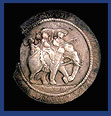
|
The term "Silk Road" or "Silk Route" was coined by the German scholar Ferdinand von Richthofen
to describe the interwoven travel passages, caravan routes and byways stretching from China to
the eastern Mediterranean, with important branches leading to the Indian subcontinent. Few
merchants made the entire journey from one terminus to the other; rather, goods exchanged hands
multiple times along the way, and for this reason it may be more useful to
think of the Silk
Route as a trade network, rather than a literal "road."
Trade goods were not the only things travelers carried with them: artistic methods and motifs, styles of music, religions, languages and literature, philosophies and political ideologies were all transported along with silks, spices, and porcelains. Rather than the luxury items that might pass from one set of hands to another, more often it was these more intangible cultural products that left the most indelible impressions. |
|
Exhibition Categories: |
 Cultures
Cultures
|
 Religions
Religions
|
 Trade
Trade
|
 Intercultural Exchange
Intercultural Exchange
|
|
Back to Open |